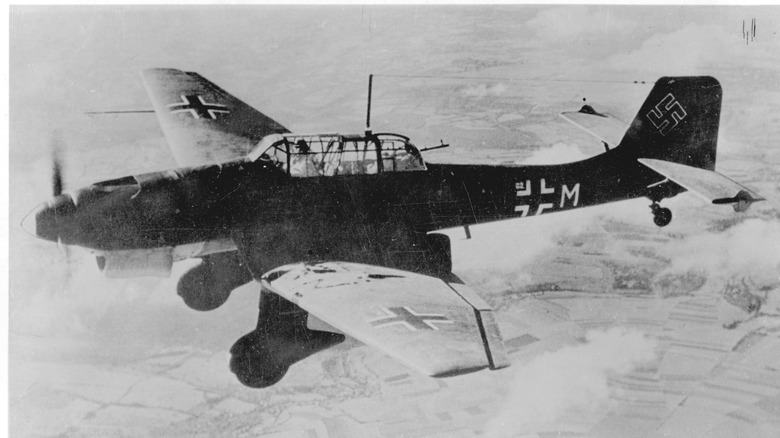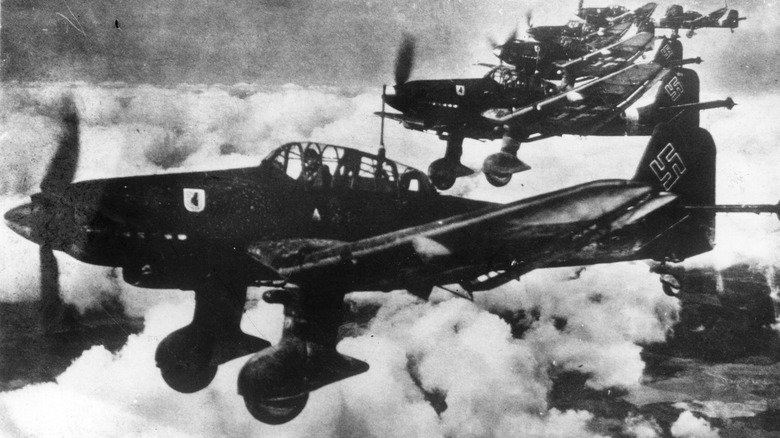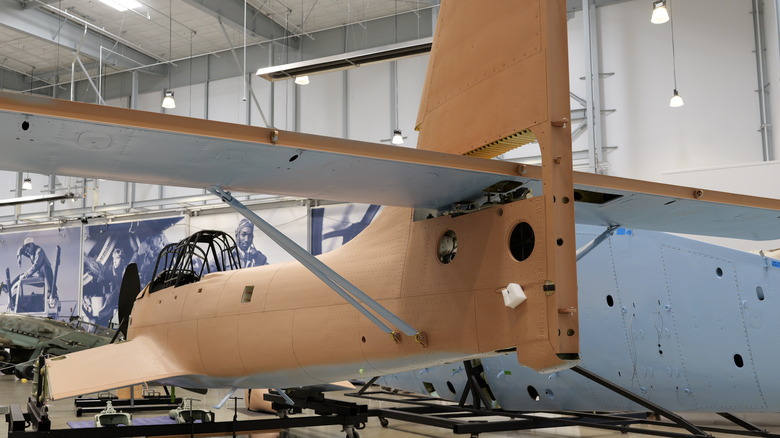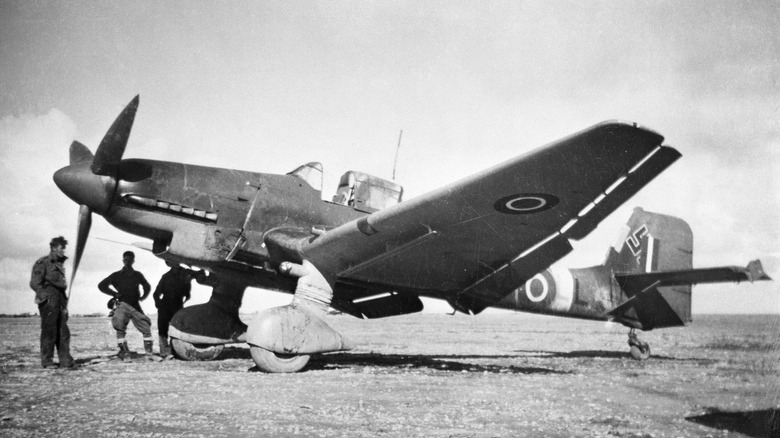Stuka Siren: Why The JU-87 Had That Terrifying And Iconic Scream
The Junkers JU-87, better known by its nickname "Stuka," was one of World War II's most iconic combat aircraft. Its distinctive inverted "gull" wings and fixed undercarriage make it unmistakable, and while its role evolved during the conflict, the basic design hardly changed. From its first flight to its last, Germany's Stuka was optimized primarily for one thing: dive bombing.
The name "Stuka" is appropriate for such a specialized airplane, being a shortening of the characteristically unwieldy compound German word "Sturzkampfflugzeug,' which literally translates to "diving combat aircraft." And perhaps uniquely in the annals of military aviation, the Stuka was intended to be as much a psychological weapon as a military one.
If you've seen director Christopher Nolan's movie 'Dunkirk,' you might recall the depiction of a Stuka attack on terrified troops waiting to be evacuated from the beaches. And if you remember the scene, you remember their sound — the otherworldly wail these planes made as they swooped down to release their bombs. That wail wasn't movie magic – in 1940, the Stuka really sounded like that. The Stuka's sirens (called "Jericho's Trumpets" by the Germans) served no practical purpose beyond adding to the terror experienced by its unfortunate victims.
Development and combat use
The Stuka was developed in the mid-1930s, as Germany, at first secretly, then openly raced to rebuild its military might. The plane's most famous supporter was German WWI flying ace Ernst Udet. Reportedly, he became fascinated by the potential of dive bombing after a visit to the 1935 Cleveland Air Races in the United States, where he saw a demonstration of the U.S. Navy Curtiss F11C-2 Goshawk biplane dive bombers. By that point, a prototype of the Stuka was already well on the way, and first flew later that same year, powered, ironically, with a British Rolls-Royce Kestrel engine.
In additional irony, some in the German high command considered the Stuka outmoded long before the fighting started. Udet might not have come up with the idea of a precision dive bomber, but he should get credit for saving the Stuka from premature cancelation after officials, including Wolfram von Richthofen, cousin of the famous "Red Baron," decided that it would be too vulnerable to be of practical use in combat.
In the end, while its slow speed and lesser armaments did make the Stuka vulnerable, it would prove to be one of Nazi Germany's most potent weapons, especially in the early years of the war. The Stuka saw some limited combat use before WWII, when small numbers were deployed to support Franco's Nationalist forces in the Spanish Civil War, but it was in the succeeding global conflict that the plane made its mark on history. Stukas dropped the first bombs on Poland in the opening salvos of WWII. In 1945, they flew their final missions in the defense of Berlin against Soviet forces.
The Stuka wail
As well as saving the Stuka from early retirement, it is thought that Ernst Udet also suggested its most famous feature — the siren (some sources say that this was an intervention by Hitler himself). The sirens were fitted to the legs of the plane's fixed undercarriage. They were driven by propellers that spun in the airflow, and could be activated and deactivated from the cockpit.
The psychological effect of the siren was best explained French general Edouard Ruby, who reportedly said that on hearing the terrifying wail, his infantrymen "cowered in the trenches, dazed by the crash of bombs and the shriek of the dive bombers." But many Stuka pilots also didn't like them. The sound was just as audible in the cockpit of the Stuka as it was to forces on the ground, and the bulky sirens added weight and reduced the speed of the already slow bomber. Reportedly, some squadrons fitted simple air whistles to the Stuka's bombs instead, creating the famous "falling bomb whistle" that Hollywood still insists that all ordnance makes as it plummets to earth.
Both the Stuka's terrifying wail and the falling bomb whistle became so famous that they have since become standard stock sound effects in movies, used whenever any airplane dives at high speed or any bomb is dropped. But, unless you're old enough to have been on the battlefields of Europe in the very earliest days of WWII, these are sounds that you'll only ever hear in movies now.
Why the Stuka was so feared
The Stuka was a specialized weapon, designed for use in aggressive actions of the kind that German forces excelled at, in the early campaigns of WWII. Unlike conventional "horizontal" bombers, which can carry more bombs, but tended to scatter them across a wide area, dive bombers are highly efficient, precision instruments. Plummeting from the sky at speeds approaching 400 mph, a well-flown Stuka could drop its cargo with almost pinpoint accuracy before pulling out of the nosedive and (in theory) swooping away to fight another day.
Although the Stuka was a relatively slow, heavy aircraft, it incorporated several highly innovative features. Aside from the famous siren, the Stuka featured an advanced bomb sight developed specifically for dive bombing, and an automatic dive recovery system to pull the aircraft out of its attacking dive without the input of the pilot. This was necessary because Stuka pilots could experience "g-forces" of several times the strength of gravity, often causing them to black out. With the automatic dive recovery control activated, the plane would recover itself, providing time for the pilot to regain consciousness and fly to safety.
Its large dive brakes were also notably advanced, allowing the Stuka to be stood – literally – on its nose, and held stable at an incredible 90 degrees to the ground without overspeeding the airframe. Famed British test pilot Eric "Winkle" Brown commented, after flying a captured JU-87, "Somehow the Ju-87D did not appear to find its natural element until it was diving steeply. The fixed undercarriage and large-span dive brakes of the Junkers were a highly effective drag combination." Alas, only two Stuka airframes survived. A third, based on an original airframe recovered from Murmansk, is currently being restored to flying condition in Washington State.



